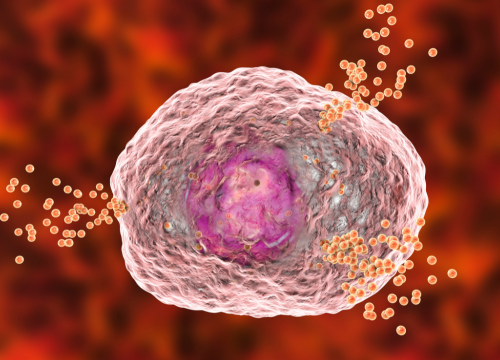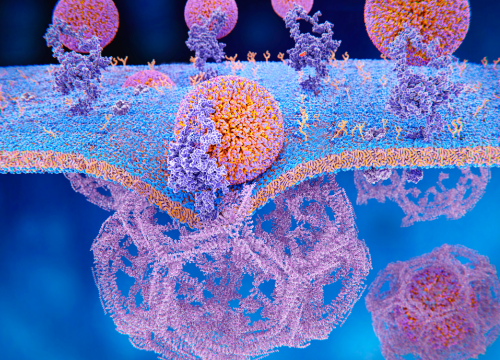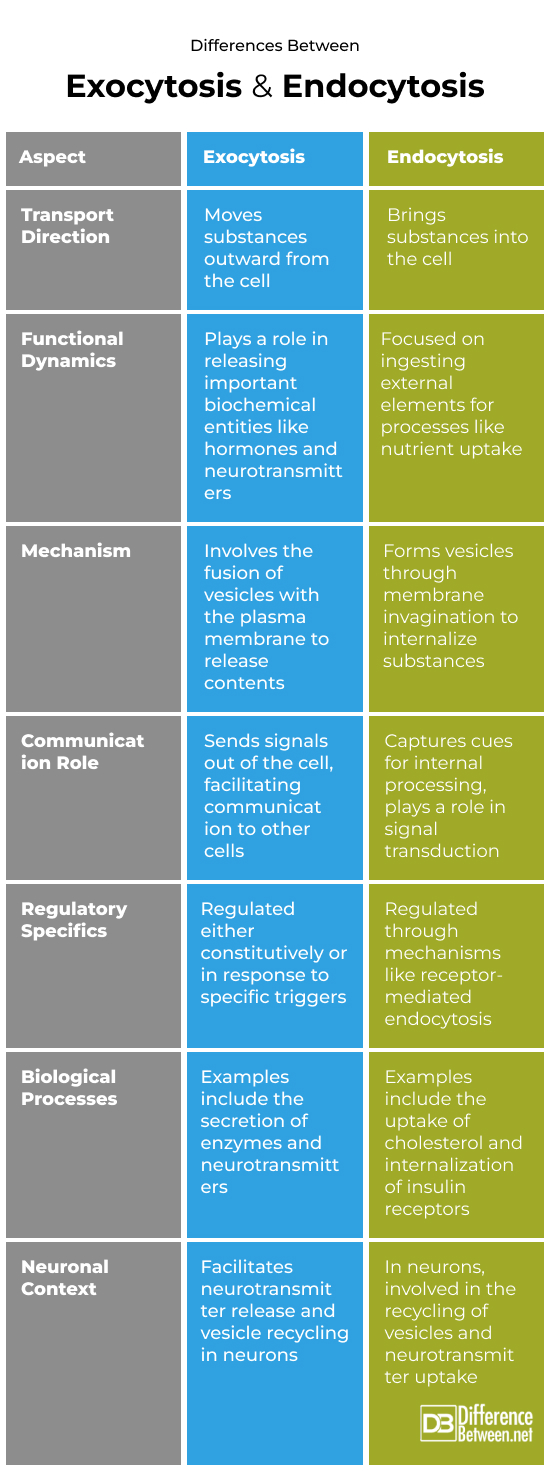Difference Between Exocytosis and Endocytosis
Introduction
The distinction, between exocytosis and endocytosis is significant when exploring the world of cells. These two processes go beyond being functions; they serve as the cells means of interacting with and responding to its environment. Understanding these processes allows us to understand the language of cells, a language that revolves around balance, adaptation and communication.

What is Exocytosis?
Let’s first delve into exocytosis. This fundamental cellular process involves materials from within the cell to the world. It plays a role in cellular functions, including waste elimination and the secretion of important substances like hormones and neurotransmitters. Essentially, it’s a way for cells to communicate with their surroundings by releasing molecules.
Mechanism:
The mechanism behind exocytosis starts with packaging materials into vesicles. These vesicles then travel towards the cell membrane fuse with it and release their contents outside of the cell.
Functions:
Exocytosis serves purposes such as removing waste secreting molecules and facilitating neurotransmitter release in nerve cells.
Types:
There are two main types; Constitutive exocytosis (a continuous process) and Regulated exocytosis (triggered by specific signals) .
Examples:
The release of insulin by pancreatic cells and neurotransmitters by neurons serve as examples that showcase the significance of exocytosis in cellular communication.

What is Endocytosis?
Definition:
Endocytosis serves as a cellular strategy for importing external elements such as fluids, large molecules, and occasionally entire cells. This process is instrumental for various cellular functions including absorbing nutrients, initiating immune reactions, and facilitating communication between cells.
Mechanism:
Endocytosis begins with the cell membrane identifying and attaching to external substances, like nutrients or signals. The membrane then folds around these items, forming a pouch. This pouch deepens and eventually separates from the membrane, creating a vesicle that carries the substances into the cell. Inside the cell, the vesicle can merge with a lysosome where its contents are processed. In certain cases, the receptors involved in capturing the external material are recycled for future use. This entire process is vital for the cell’s nutrient absorption, response to external signals, immune functions, and maintaining the balance of receptors on the cell surface.
Functions:
Endocytosis plays a versatile and vital role in cellular functioning. It’s like the cell’s method of shopping and communication; it picks up essential nutrients like sugars and fats from the outside, which are crucial for the cell’s health and energy. It also acts like a cell’s control knob, adjusting how the cell responds to signals by managing its surface receptors. In the realm of defense, it’s like a microscopic security system, capturing and neutralizing harmful invaders such as pathogens. For communication, it’s akin to a postal service, helping the cell receive and interpret messages from its neighbors. In medical science, this process is harnessed to deliver treatments right into the cell. Lastly, think of it as a recycling mechanism, efficiently managing the cell’s internal resources. In essence, endocytosis is key to how a cell feeds, communicates, protects itself, and stays efficient.
Types:
Endocytosis comes in various forms, each tailored for specific tasks:
- Phagocytosis: Think of it as the cell’s way of ‘eating’ large items, like bacteria or dead cells, mainly occurring in immune cells like macrophages.
- Pinocytosis: More like ‘cellular sipping,’ it continually takes in surrounding fluid, along with its dissolved nutrients, a common process across many cell types.
- Receptor-Mediated Endocytosis: This selective approach lets cells pick and choose specific molecules (like hormones) to absorb, using specialized receptors.
- Caveolar Endocytosis: Involving tiny flask-like structures on the cell surface, it’s key for moving diverse molecules and plays a role in cellular signaling and cholesterol management.
- Clathrin-Mediated Endocytosis: Featuring the protein clathrin, this type creates vesicles for the uptake of crucial molecules, a highly researched mechanism in cellular biology.
Each type ensures that cells efficiently interact with and adapt to their environment, highlighting the cell’s remarkable versatility.
Examples:
Cells across the body use endocytosis to bring in growth factors, such as EGF, crucial for processes like cell growth and healing.
Like microscopic Pac-Men, immune cells like neutrophils and macrophages gobble up bacteria via phagocytosis, a pivotal defensive strategy against infections.
Liver cells cleverly use endocytosis to keep cholesterol levels in check, pulling in low-density lipoproteins (the notorious LDL) from the bloodstream.
In the lab, scientists track endocytosis in action by watching cells swallow up glowing, fluorescently tagged molecules, making it a vital tool for cellular study.
Similarities Between Exocytosis and Endocytosis:
- Exocytosis and endocytosis although functionally opposite have similarities.
- They both have interactions, with the cell membrane; exocytosis involves merging vesicles to release materials outward while endocytosis involves folding the membrane to bring substances inside.
- Both processes rely on vesicles for transportation. Exocytosis for exporting and endocytosis for importing.
- In terms of energy requirements both processes depend on ATP to fuel their activities.
- They are also regulated by signals adapting their actions according to the cells environment and needs.
- In terms of communication exocytosis can be compared to a cells broadcasting system sending out signals whereas endocytosis plays the role of a receptionist by receiving messages.
- The molecular tools utilized in these processes including proteins and enzymes exhibit similarities as they contribute to vesicle formation and fusion.
- Lastly both exocytosis and endocytosis play a role in remodeling the cells surface area. Exocytosis, by adding to it and endocytosis by reducing it.
These shared characteristics emphasize their roles in maintaining balance and facilitating communication.
Differences Between Exocytosis and Endocytosis:
- Exocytosis moves substances outward while endocytosis brings them inward.
- Functional Dynamics: Exocytosis is responsible for releasing substances while endocytosis focuses on the uptake of external elements.
- Mechanism: Exocytosis occurs when vesicles fuse with the plasma membrane whereas endocytosis forms vesicles through the invagination of the membrane.
- Communication Role: Exocytosis allows signals to be sent out of the cell while endocytosis captures cues for processing.
- Regulatory Specifics: Each process has its regulation that highlights different aspects of cellular control.
- Biological Processes: Examples include the secretion of enzymes (exocytosis) and the uptake of cholesterol (endocytosis).
- Neuronal Context: In neurons these processes work together to facilitate neurotransmission and recycle vesicles.

Summary
Exocytosis and endocytosis are concepts in cell biology. They represent how cells interact with their environment in a communicative and adaptable manner. Although they are two different processes, they play crucial roles in maintaining life’s intricate dance within cells.
FAQs
How do endocytosis and exocytosis differ from diffusion?
Endocytosis and exocytosis involve the cell actively transporting substances in and out using energy, while diffusion is a passive process where substances move from an area of high concentration to low concentration without energy use.
Think of endocytosis and exocytosis as active movers, using energy to transport stuff, while diffusion is more like a natural flow, moving substances down their concentration gradient, no energy needed.
What distinctively separates exocytosis from endocytosis?
The main difference is direction. Exocytosis pushes substances out of the cell, and endocytosis brings them in.
Here’s the deal: exocytosis is like a cell throwing out trash or sending messages out, while endocytosis is like the cell swallowing something, bringing it inside.
How do endocytosis and exocytosis differ from osmosis?
Osmosis refers to the movement of water across a membrane that allows only certain substances to pass through from areas, with lower solute concentration to those with solute concentration. However endocytosis and exocytosis are processes that involve the transportation of substances, across the cell membrane not limited to water.
Imagine osmosis as water’s sneak way of balancing itself through a membrane, while endocytosis and exocytosis are the cell’s way of dealing with more than just water, actively moving a variety of substances and using energy.
What is a key characteristic differentiating endocytosis from exocytosis?
Endocytosis is about cell intake or absorption of materials, while exocytosis is about cell release or secretion of materials.
What are the three types of endocytosis, and can you define exocytosis?
Endocytosis takes three forms:
- phagocytosis for engulfing particles
- pinocytosis, for taking in fluids
- receptor mediated endocytosis.
Exocytosis involves the fusion of vesicles, with the cell membrane to release their contents outside the cell.
Can you briefly describe the processes of endocytosis and exocytosis?
There are types of endocytosis including phagocytosis, pinocytosis and receptor mediated endocytosis. Exocytosis varies depending on what’s being released like neurotransmitters in neurons or hormones, in endocrine cells.
What are the different types of endocytosis and exocytosis?
Endocytosis takes three forms:
- phagocytosis for engulfing particles
- pinocytosis, for taking in fluids
- receptor mediated endocytosis.
Exocytosis can be Constant sending (constitutive) or special deliveries (regulated).
- Difference Between Suicide and Euthanasia - May 22, 2024
- Difference Between Vitamin D and Vitamin D3 - May 21, 2024
- Difference Between Running Shoes and Walking Shoes - April 30, 2024
Search DifferenceBetween.net :
3 Comments
Leave a Response
References :
[0](i) Battey, N. H., James, N. C., Greenland, A. J., & Brownlee, C. (1999). Exocytosis and Endocytosis. The Plant Cell, 11(4), 643–659. https://doi.org/10.1105/tpc.11.4.643
[1](ii) Alberts, B., Heald, R., Johnson, A., Morgan, D. O., Raff, M. C., Roberts, K., & Walter, P. (2022). Molecular biology of the cell. (Chapter “Intracellular Membrane Traffic,” pp. 749-810). W. W. Norton & Company.
[2](iii) Alberts, B., Heald, R., Johnson, A., Morgan, D. O., Raff, M. C., Roberts, K., & Walter, P. (2022). Molecular biology of the cell. (Chapter “Intracellular Membrane Traffic,” pp. 749-810). W. W. Norton & Company.
[3](iv) Alberts, B., Heald, R., Johnson, A., Morgan, D. O., Raff, M. C., Roberts, K., & Walter, P. (2022). Molecular biology of the cell. (Chapter “Intracellular Membrane Traffic,” pp. 749-810). W. W. Norton & Company.
[4](v) Alberts, B., Heald, R., Johnson, A., Morgan, D. O., Raff, M. C., Roberts, K., & Walter, P. (2022). Molecular biology of the cell. (Chapter “Intracellular Membrane Traffic,” pp. 749-810). W. W. Norton & Company.
[5](vi) Battey, N. H., James, N. C., Greenland, A. J., & Brownlee, C. (1999). Exocytosis and Endocytosis. The Plant Cell, 11(4), 643–659. https://doi.org/10.1105/tpc.11.4.643
[6](vii) Alberts, B., Heald, R., Johnson, A., Morgan, D. O., Raff, M. C., Roberts, K., & Walter, P. (2022). Molecular biology of the cell. (Chapter “Intracellular Membrane Traffic,” pp. 749-810). W. W. Norton & Company.
[7](viii) Alberts, B., Heald, R., Johnson, A., Morgan, D. O., Raff, M. C., Roberts, K., & Walter, P. (2022). Molecular biology of the cell. (Chapter “Intracellular Membrane Traffic,” pp. 749-810). W. W. Norton & Company.
[8](ix) Alberts, B., Heald, R., Johnson, A., Morgan, D. O., Raff, M. C., Roberts, K., & Walter, P. (2022). Molecular biology of the cell. (Chapter “Intracellular Membrane Traffic,” pp. 749-810). W. W. Norton & Company.
[9]Alberts, B., Heald, R., Johnson, A., Morgan, D. O., Raff, M. C., Roberts, K., & Walter, P. (2022). Molecular biology of the cell. (Chapter “Intracellular Membrane Traffic,” pp. 749-810). W. W. Norton & Company.
[10]Battey, N. H., James, N. C., Greenland, A. J., & Brownlee, C. (1999). Exocytosis and Endocytosis. The Plant Cell, 11(4), 643–659. https://doi.org/10.1105/tpc.11.4.643
[11]Image credit: https://www.canva.com/photos/MADq3nesv44-f017-9474/
[12]Image credit: https://www.canva.com/photos/MADq3y-1E3Q-f021-4125/

I NEED HELP LIKE BIG TIME I DO NOT UNDERSTAND NOTHING ABOUT THYIS SOO WILL YOU HELP ME COUSE MY PROJECT IS DUE SOON 8(((
what kind project are u working on.
no need of comparison just difference is required